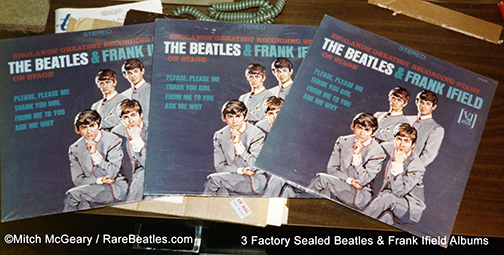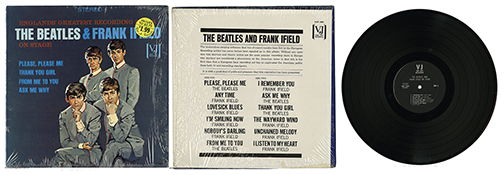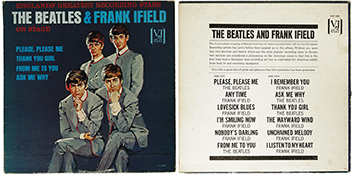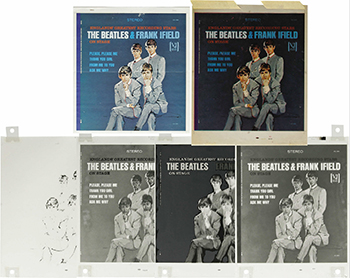





| The Beatles & Frank Ifield LP on VJ Records
One of the rarest and most valuable of all Beatles records ever issued |
 |
|
This album is one of the rarest and most valuable of all Beatles albums ever issued. It was the last album manufactured by Vee Jay Records, before their rights to the Beatles were to expire on Oct. 10, 1964. They had taken their Jolly What! The Beatles and Frank Ifield On Stage album, of which the cover had a drawing of a British Statesman (referred by collectors as the "old man" cover) and quickly redesigned a new cover, prominently featuring a drawing of the Beatles (commonly referred to as the "portrait" cover), for a rush release in late summer of 1964. This re-issue version hardly made it to record stores, and less than 100 copies are believed to have been manufactured. The FIRST time that a factory sealed copy turned up in the collecting world was in 1976, when Northwest USA collector Mitch McGeary of Ticket To Ryde Ltd. discovered THREE(!) STEREO unopened copies in the basement of a midwest record store (stereo copies of VJ albums are much scarcer than mono copies and typically sell for two or more times the mono price). A fourth stereo copy, opened but still in its original shrinkwrap, was discovered at the same location a few weeks later. The three sealed copies were individually sold over the next two years, the first copy to Kelsy Crossman of Kent, WA USA for $600, the second to a West Coast collector for $900, and the last one to long-time veteran collector Gareth Pawlowski for $1,800. Two of the three copies had the price stickers removed for unknown reasons, leaving a hole in the shrink wrap on the front covers. As of the year 2021 - 45 years later and nearly 57 years after its initial release, not another single sealed copy has ever turned up. In 1995, one of the three copies sold for $22,000, and reportedly into a "permanent" collection (the buyer claimed at the time that he would unlikely ever re-sell the album). Another one was last heard of in the New York area in the mid-late 1990s with an asking price of $25,000. In the past few years, an opened but still shrinkwrapped copy has been advertised by an overseas collector for $18,000. None of the sealed copies have turned up for sale in the past 25 or so years. As of March 2021, no original sealed MONO copies have ever turned up. Counterfeits: Genuine portrait covers have excellent print quality, with a speckled blue/green background. Known counterfeits have a solid blue background and lack printing on the spine. |
 |
 |
 |
 |
| Shown above is the far more common first version with the "Jolly What!" subtitle and portrait of a British Statesman wearing a Beatle wig. The LP was released February 26, 1964, 46 days after Meet The Beatles. It was issued in both mono and stereo with three different label styles- black label w/colorband and oval logo; with colorband and brackets label; and an all-black label with silver print. Counterfeits of the LP first appeared in the late 1970s, and can easily be identified by their lack of any spine writing, and a black background instead of dark blue or purple like the originals. Original copies in upper grade near mint condition are currently (March 2021) selling for around $200-$300. |
 |
| Extremely scarce "press proof" materials for the portrait cover, including a beautiful set of color keys (four film positive sheets that seen together form a single full-color image), plus two press proof sheets (one in full color, the other printed in only blue and yellow). Also included in the lot were a set of four original film negatives, one each for red (magenta), blue (cyan), yellow, and black. These press proofs were sold by Heritage Auctions 15 years ago, on April 15, 2006 for $5,676.25 (including Buyer's Premium). |
|
|
| Envelope that the proofs were stored in, and the blue/yellow proof. |
| Frank Ifield |
 |
| Frank Ifield began recording at age 13 and in six years had 44 records issued in Australia and became the Number One Recording star in Australia, New Zealand, and Tasmania before he was nineteen. Signed by EMI Records on Columbia shortly after he came to London, Frank zoomed to the top of their most popular recording artists with I Remember You, followed soon afterwards by Lovesick Blues, Nobody's Darling But Mine, Confessin', The Wayward Wind and Waltzing Matilda (now almost his signature tune, so popular was his record of this beloved Australian ditty). From being unknown in 1959, Frank soared to the dizzy heights of stardom in 1962, remaining there for more than three decades. He has issued more than thirty EPs and twenty albums. In an interview I had with him some years back, he was surprised at hearing that his album "with" the Beatles has been, and still is, among the rarest and most valuable of all albums in the world. |
 |
| An original autographed program from the December 12, 1962 show at the Embassy cinema in Peterborough, England which featured headliner Frank Ifield, and The Beatles. This unusual combination of acts resulted from a phone call by Brian Epstein to Arthur Howes, then the country's biggest tour promoter, offering the Beatles. Mr. Howes agreed to a one night trial for the Beatles to appear with Frank Ifield, and their appearance was an embarassing flop. The audience had come to see Frank, not "four unknowns" from Liverpool. Better days soon followed, as the next day Love Me Do entered the top twenty. Five days later they set off for Hamburg and the Star-Club, where one of the songs they performed was the Frank Ifield hit, I Remember You. |
| Visit Frank Ifield's website |

